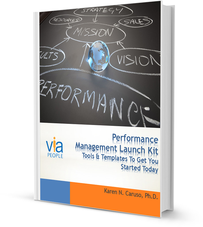 Although all of the performance review naysayers might have you believe that the general populace despises the practice of assessing performance, my team and I are on the front line of working with people everyday who beg to differ. It is always my pleasure to speak with employees and managers after they have received performance feedback – some of it glowing, much of it developmental and growth-oriented. During performance review and regular coaching discussions, managers consider the performance feedback from various sources and perspectives and wield it into a tool, a plan really, for moving forward. More often than not these conversations become an intensely introspective exercise that provides the spark for change. Engaging in such breakthrough dialogue is only made possible by the managers and other feedback providers who sacrificed a bit of time from their lengthy to-do list to gift this individual with direct and honest feedback on their performance. In my experience, it is something that most people take seriously, and in fact are extremely grateful to have received.
Although all of the performance review naysayers might have you believe that the general populace despises the practice of assessing performance, my team and I are on the front line of working with people everyday who beg to differ. It is always my pleasure to speak with employees and managers after they have received performance feedback – some of it glowing, much of it developmental and growth-oriented. During performance review and regular coaching discussions, managers consider the performance feedback from various sources and perspectives and wield it into a tool, a plan really, for moving forward. More often than not these conversations become an intensely introspective exercise that provides the spark for change. Engaging in such breakthrough dialogue is only made possible by the managers and other feedback providers who sacrificed a bit of time from their lengthy to-do list to gift this individual with direct and honest feedback on their performance. In my experience, it is something that most people take seriously, and in fact are extremely grateful to have received.
I think this is what we in the industry and HR sometimes lose sight of when talking about the administrative pains of the employee performance review process. We often get wrapped up in the negative perceptions of performance reviews, especially given the recent tales from Yahoo, Motorola and Microsoft. Certainly a poorly run process that focuses purely on ratings or rankings, fails to leverage technology (or does so incorrectly), or asks employees and managers to jump through ridiculous hoops to provide feedback will spur some hatred towards the process. That is probably why we never get this feedback from out clients. We simply don’t let this happen.
So this Thanksgiving season, I would urge HR leaders to re-examine their employee performance management systems.
Assess the Current State of Affairs: Consider how well your company's current process actually improves performance and develops your people. Spend time interviewing employees, managers and other stakeholders to gain their persepctives on how the process can be improved.
Design Your New Process: Identify the best opportunities for improvement and craft a new process/set of tools that will support your goals. Find ways to leverage technology to remove administrative burdens and allow for the continuous flow of feedback. Don’t be afraid to simplify and always keep in mind the goal that the data collected is not really for you, the CEO or shareholders. The performance management process and the feedback collected is for the employee.
Plan and Execute the New Process: Create a formal change plan to introduce your updated performance management process. Be sure to include ample communication and targeted resources so that employees and managers have the tools required for success.
While the holidays can be a whirlwind of activity and a bit stressful, it is also a time for rejuvenation and planning for the future. Download viaPeople's Performance Management Launch Kit for a step-by-step guide, including tools and templates, for implementing a new employee performance management process.

